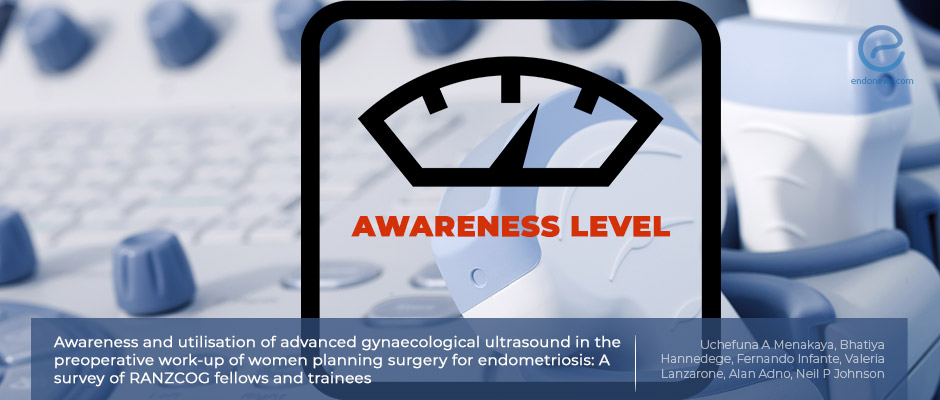“Advanced gynecological ultrasound” for women with suspected endometriosis
Apr 1, 2021
Preoperative "endometriosis-specific" ultrasound is valuable for women with suspected endometriosis.
Key Points
Highlights:
- "Advanced pelvic ultrasound" examination in women with suspected endometriosis is important for planning the treatment.
Importance:
- The preoperative ""endometriosis-specific" detailed ultrasonographic evaluation of women with suspected endometriosis has important value as a part of preoperative work-up.
What’s done here?
- This survey-based study was conducted among active RANZCOG (Royal Australian and New Zealand College of Obstetricians and Gynecologists) fellows and trainees.
- The aim was to determine the respondents’ awareness and utilization of "advanced gynecological ultrasound" as a part of preoperative work-up in women with suspected endometriosis.
- Advanced gynecological ultrasound (endometriosis-specific ultrasound) was defined as a detailed and targeted assessment of the pelvis using specific ultrasound techniques by an experienced sonologist.
- The online survey had 22 questions in four sections, and included demographic data, clinical preference of gynecological imaging to plan surgery for endometriosis, their awareness and utilisation of advanced gynecological imaging in women with suspected endometriosis.
Key results:
- Total response rate was 17% (437/2567) in this study. Routine pelvic ultrasound was the most commonly preferred method (88.9%).
- Additional imaging modalities such as computed tomography and MRI were selected (25.6%) as a part of preoperative assessment.
- Advanced gynecological ultrasound was also preferred as an addition to plan the endometriosis treatment, by 32% of the respondents.
- Advanced "gynaecological ultrasound" was the preferred method by laparoscopic surgeons compared to the general obstetricians and gynaecologists.
- The lack of local expertise, cost, preference for diagnostic laparoscopy as first-step procedure and a lack of RANZCOG/AGES guidelines to support its clinical utilization were reported as limitations by the respondents to use advanced gynecological ultrasound in the patients having suspected endometriosis.
Limitations
- The limitations were low response rate and limited experience of the respondents about the technique of advanced gynecologic ultrasonography.
- The inclusion of respondents who are obstetric sonographist and feto‐maternal medicine experts who do not perform laparoscopic surgeries is another limitation.
Lay Summary
Different clinical forms of endometriosis such as superficial endometriosis, endometrioma, and deep infiltrating endometriosis are present. Although no specific diagnostic tool is available for endometriosis, clinical findings, physical examination and imaging including transvaginal ultrasound and MRI are helpful to determine the treatment and to counsel these patients.
Menakaya et al., from Australia and New Zealand, published a study entitled “Awareness and utilisation of advanced gynaecological ultrasound in the preoperative work-up of women planning surgery for endometriosis: A survey of RANZCOG fellows and trainees” in the scientific journal "Australian New Zealand Journal of Obstetrics and Gynaecology".
The authors aimed to evaluate awareness and wish for utilisation of "advanced gynecological ultrasound" as a part of preoperative work-up in women with suspected endometriosis among active RANZCOG (Royal Australian and New Zealand College of Obstetricians and Gynecologists) fellows and trainees. An online survey that included 22 questions was completed by the respondents.
"Advanced gynecological ultrasound” was defined as "detailed and targeted assessment of the pelvis using specific ultrasound techniques by an experienced sonologist".
Routine pelvic examination using ultrasound was the most common preferred imaging method, whereas additional imaging modalities such as computed tomography, and MRI were selected for recommendation as a part of preoperative assessment in women with suspected endometriosis. The obtion of "advanced gynecological ultrasound" was also selected as an additional technique to be requested to plan medical and/or surgical treatment of endometriosis patients in one-third of the respondants. Advanced "gynaecological ultrasound" was a more preferred method by laparoscopic surgeons compared to the general obstetricians and gynaecologists.
Limitations for using advanced gynecological ultrasound in patients with suspected endometriosis were: lack of experience, cost to the patient and to the health system, the preference of diagnostic laparoscopy as first-step procedure, and the lack of RANZCOG/AGES guidelines to support its clinical utilization.
“Although we demonstrated an awareness ofeEndometriosis-specific "advanced gynecological" ultrasound among RANZCOG fellows and trainees, their current pattern of utilization likely reflects the limited availability of local expertise required for endometriosis‐specific ultrasound in some parts of Australia and New Zealand. Overcoming this challenge would require a more‐targeted and strategic approach to capacity‐building efforts in endometriosis‐specific ultrasound" the authors added.
Research Source: https://pubmed.ncbi.nlm.nih.gov/33667321/
advanced gynecological ultrasound endometriosis awareness utilisation magnetic resonance imaging

